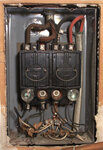Axel114
Newbie level 6

An update: I bought a new 1100-watt microwave (does not have an inverter, nor does the old one). It also dims the lights, but not quite as bad. The light on the extension cord dims a lot but has not flickered or gone out completely. I don't know what to think. The light inside the microwave dims quite noticeably when the magnetron comes on. Is this normal? I don't remember this happening before, but now I'm beginning to wonder. Can anyone confirm this does/does not happen to theirs?
dick_freebird: That's an interesting possibility and one that I'll check out.
dick_freebird: That's an interesting possibility and one that I'll check out.




